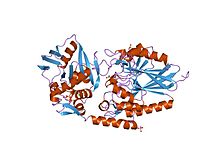| 5_nucleotid_C | |||||||||
|---|---|---|---|---|---|---|---|---|---|
 5'-nucleotidase (open form) complex with atp | |||||||||
| Identifiers | |||||||||
| Symbol | 5_nucleotid_C | ||||||||
| Pfam | PF02872 | ||||||||
| InterPro | IPR008334 | ||||||||
| PROSITE | PDOC00627 | ||||||||
| SCOP2 | 1ush / SCOPe / SUPFAM | ||||||||
| |||||||||
5'-nucleotidases EC [1] are enzymes that catalyze the hydrolysis of phosphate esterified at carbon 5' of the ribose and deoxyribose portions of nucleotide molecules. 5'-nucleotidase is a ubiquitous enzyme found in a wide variety of species and which occurs in different cellular locations. The extracellular 5'-nucleotidase from mammals and Discopyge ommata (Electric ray) isozyme is a homodimeric disulphide-bonded glycoprotein attached to the membrane by a GPI-anchor, and requires zinc for its activity. Vibrio parahaemolyticus 5'-nucleotidase (gene nutA) is bound to the membrane by a lipid chain, and requires chloride and magnesium ions for its activity. It is involved in degrading extracellular 5'-nucleotides for nutritional needs.
Periplasmic bacterial 5'-nucleotidase (gene ushA), also known as UDP-sugar hydrolase EC, can degrade UDP-glucose and other nucleotide diphosphate sugars. It produces sugar-1-phosphate which can then be used by the cell. UshA seems to require cobalt for its activity. 5'-Nucleotidases are evolutionary related to the periplasmic bacterial 2',3'-cyclic-nucleotide 2'-phosphodiesterase EC (gene cpdB), which catalyzes two consecutive reactions: it first converts 2',3'-cyclic-nucleotide to 3'-nucleotide and then acts as a 3'-nucleotidase; and mosquito apyrase EC (ATP-diphosphohydrolase),[2] which catalyzes the hydrolysis of ATP into AMP and facilitates hematophagy by preventing ADP-dependent platelet aggregation in the host.
CD73 (also called ecto-5'-nucleotidase) possesses the enzymatic activity of a 5'-nucleotidase and catalyses the dephosphorylation of purine and pyrimidine ribo- and deoxyribonucleoside monophosphates to their corresponding nucleosides. Triggering of lymphocyte CD73 with mAb causes phosphorylation and dephosphorylation of certain, yet unknown protein substrates.[3] A possible function for CD73 is to regulate the availability of adenosine for interaction with cell surface adenosine receptor by converting AMP to adenosine. In common with other GPI anchored surface proteins CD73 can mediate costimulatory signals in T cell activation.[4]
This entry is the C-terminal domain of 5'-nucleotidases.
References
edit- ^ Zimmermann H (July 1992). "5'-Nucleotidase: molecular structure and functional aspects". Biochem. J. 285 ( Pt 2): 345â65. doi:10.1042/bj2850345. PMC 1132794. PMID 1637327.
{{cite journal}}: C1 control character in|pages=at position 5 (help)CS1 maint: date and year (link) - ^ Champagne DE, Smartt CT, Ribeiro JM, James AA (January 1995). "The salivary gland-specific apyrase of the mosquito Aedes aegypti is a member of the 5'-nucleotidase family". Proc. Natl. Acad. Sci. U.S.A. 92 (3): 694–698. doi:10.1073/pnas.92.3.694. PMC 42686. PMID 7846038.
{{cite journal}}: CS1 maint: date and year (link) CS1 maint: multiple names: authors list (link) - ^ Airas L, Niemelä J, Salmi M, Puurunen T, Smith DJ, Jalkanen S (January 1997). "Differential regulation and function of CD73, a glycosyl-phosphatidylinositol-linked 70-kD adhesion molecule, on lymphocytes and endothelial cells". J. Cell Biol. 136 (2): 421â31. doi:10.1083/jcb.136.2.421. PMC 2134816. PMID 9015312.
{{cite journal}}: C1 control character in|pages=at position 5 (help)CS1 maint: date and year (link) CS1 maint: multiple names: authors list (link) - ^ Thompson LF, Ruedi JM, Glass A, Low MG, Lucas AH (September 1989). "Antibodies to 5'-nucleotidase (CD73), a glycosyl-phosphatidylinositol-anchored protein, cause human peripheral blood T cells to proliferate". J. Immunol. 143 (6): 1815â21. doi:10.4049/jimmunol.143.6.1815. PMID 2550543.
{{cite journal}}: C1 control character in|pages=at position 6 (help)CS1 maint: date and year (link) CS1 maint: multiple names: authors list (link)